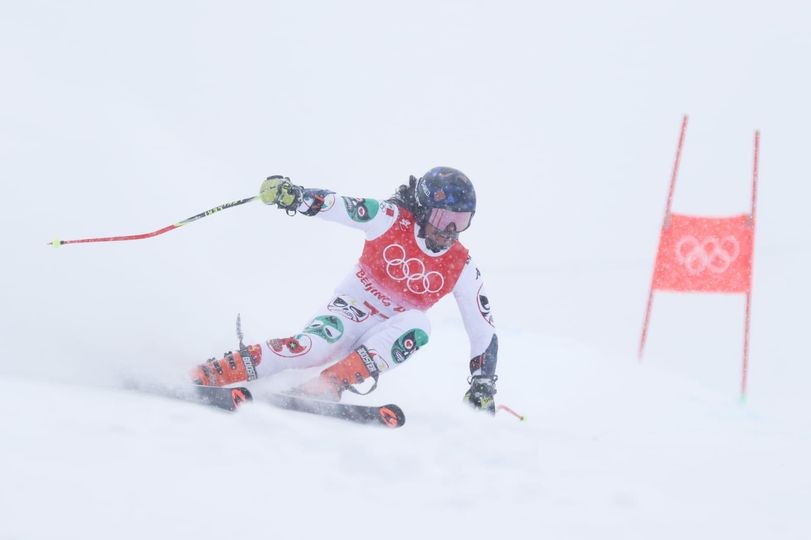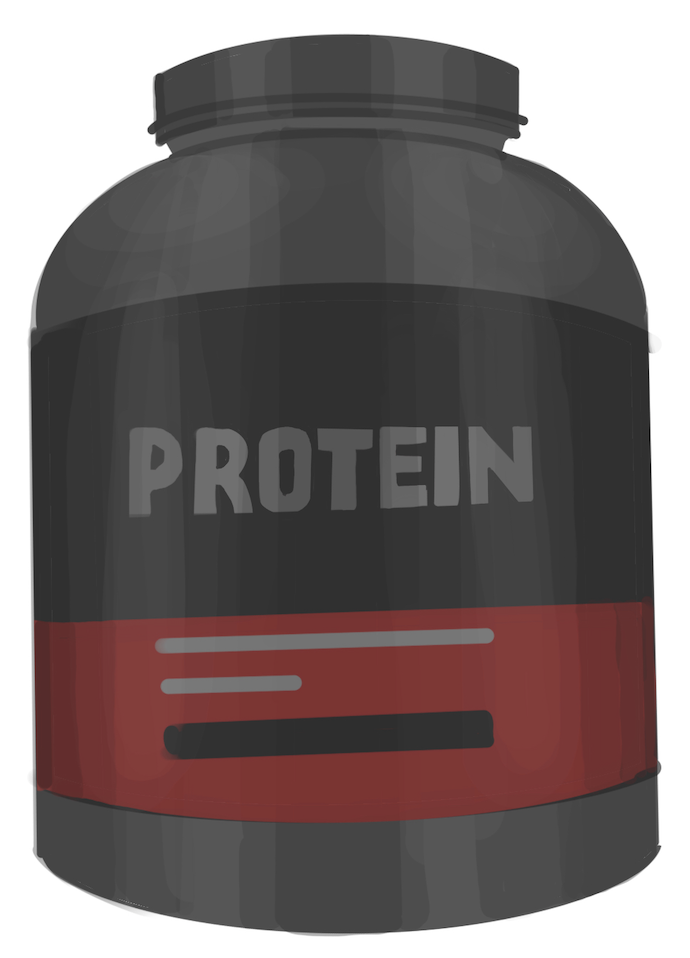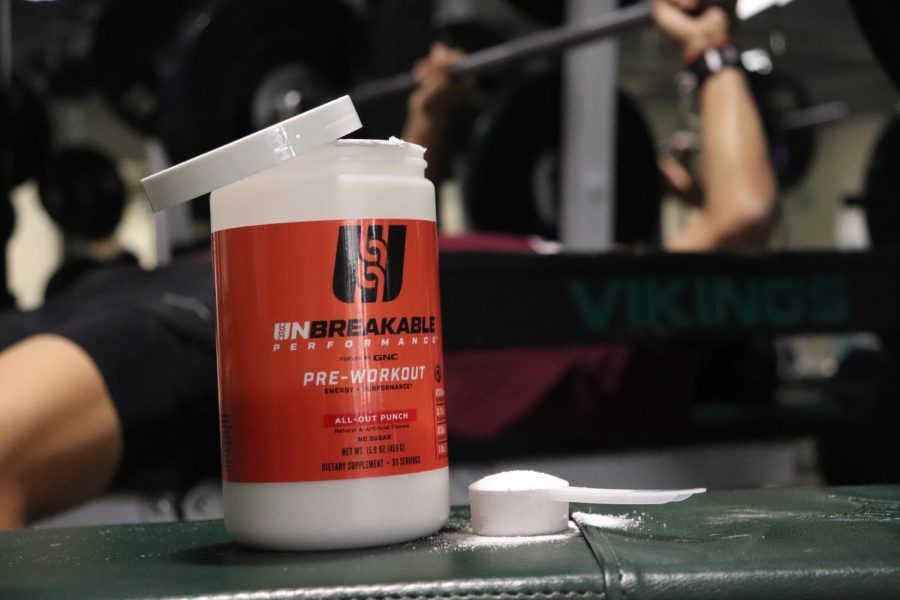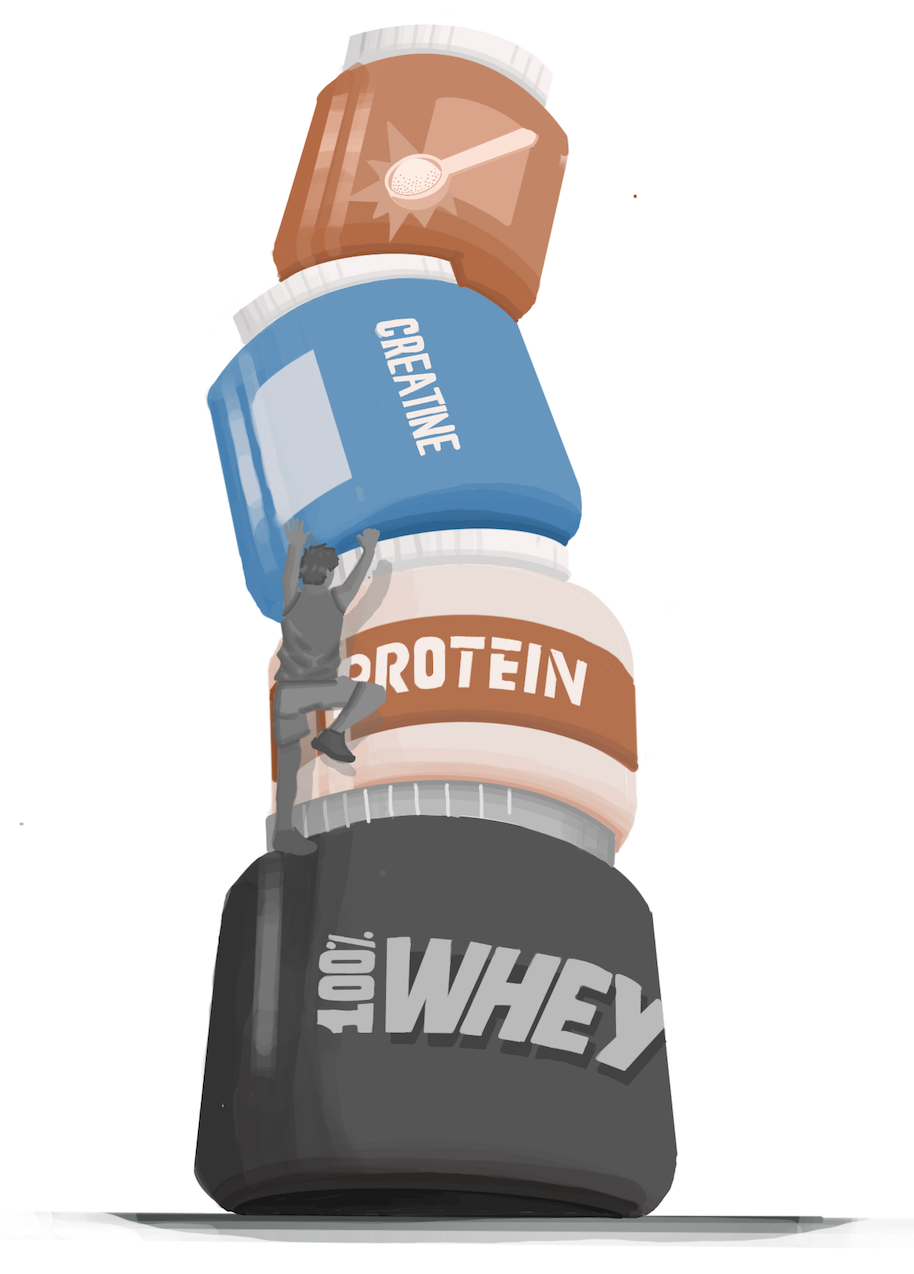Supplements: Where to Draw the Line
With many large-scale international competitions such as the Olympic and Paralympic games being the center of the sporting world, and the increased prominence of transgender athletes, the discussion surrounding performance enhancing drugs (PED) and other legal and illegal substance use has become prominent. This exposes concerns on the ethics and the integrity of the competitions and leads to the question: where should we draw the line between legal and illegal substances?
From powders to pills, performance-enhancing substances range from basic supplements (like vitamins or protein) to partially-legal supplements used among the Paly athletic community (like Creatine and Caffeine) to illegal drugs like steroids or human growth hormones (HGH).
In recent years, the discussion surrounding the legality and ethicality of supplements has become more prominent, amid Olympic controversy and the discussion surrounding transgender athletes. The question of where to draw the line when it comes to supplements has become increasingly important.
Current regulation around supplement use is, to say the least, incredibly complicated. Various groups have different rules, but the bylaws of the International Olympic Committee (IOC) are typically seen as the most strict, and a good starting point for other groups. Currently, the IOC prohibits the use of any type of sports supplement during the games, including seemingly benign ones like caffeine, creatine, and sodium bicarbonate (baking soda).
I think that taking [creatine] is a very low risk… because it’s… naturally occurring
— Max Schrage
The banning of Creatine is an especially controversial point, as its use is incredibly popular, even here at Paly. Creatine is a naturally occurring chemical used to increase an individual’s maximum power and aerobic range. The substance was deemed safe for short-term usage, but the lack of long-term data raises questions regarding the use of creatine for extended periods, which is why the IOC decided to ban its use.
Paly students reflect on their Creatine use, especially the looming question of its safety.
“I think that taking [Creatine] is a very low risk and that it’s not going to have long-lasting effects, especially because it’s a naturally occurring substance in different types of meats and other proteins,” junior Max Schrage said. “There have been a lot of studies on it, just not necessarily long-term, because it’s something that’s been kind of recently put into the spotlight. There haven’t been any negative effects surrounding it.”
Schrage, who feels that the naturally-occurring Creatine is safe enough, has been taking it for five months. He also notes only positive effects after starting on Creatine, seeing an increase in both strength and appearance. Once Schrage started Creatine and coupled it with consistent training, he felt more physically strong.
“I’m proud of myself for the changes I see in the gym, and I feel that Creatine really sped up the whole process,” Schrage said.
The use of supplements is also seen in the higher level of sports. Olympic ski racer Rodolfo “Rudy” Dickson uses naturally occurring substances to stay in shape all year round. Dickson is a professional ski racer for the Mexican Olympic team and has competed in both the 2018 PyeongChang Olympics and the more recent 2022 Beijing Olympics. He emphasizes the importance of researching the effects of the supplements he uses. This includes finding more information about the substance and performing trial and error of use.
“A little bit of research does help, so I go online like I’m sure everyone does that to an extent,” Dickson said. “You got to try it for a bit as well. If you take a pre-workout, for example, like caffeine and you don’t feel good, you stop taking it, pretty simple.”
The most influential supplement Dickson takes is caffeine, which he takes as part of his pre-workout, and is especially important before his first and second run. Caffeine acts as a stimulant that will help engage the body, so Dickson takes it to boost both his physical and mental ability preceding a ski run. He gets his caffeine from his pre-workout because coffee provides an inconsistent amount of caffeine wherein with one scoop of pre-workout he can know exactly how much caffeine he is taking.
Creatine is a big part of Dickson’s pre-workout, which he uses almost every day before weight training or before he goes out on the slopes. However, Dickson does not think supplements like creatine are needed to succeed in ski racing.
“[Creatine] does help to a certain percent, but is it super measurable? Not really, maybe on paper, but I can’t see any difference in the short term,” Dickson said.
Because ski racing is not solely strength-based, other factors are more influential in being an all-around good racer. Creatine’s main effect is to retain water in muscles, and although it does elevate your strength and recovery, in a sport like ski racing that relies more heavily on technique and mental strength creatine is less of a prominent component than it would be in a sport such as weightlifting.

This is also why you rarely see alpine ski racers faced with doping scandals at the professional level. There is less of a need to take illegal substances to get an edge on your opponents, as it wouldn’t give you that much of a benefit over your competitors.
“I think you can do it without it,” Dickson said. “It’s better to have a better-rounded out meal plan and good workouts.”
On the other hand, in sports where strength is more of an aspect when competing at a high level, some athletes will go so far as to take illegal substances to enhance their performance. To combat the athletes’ malicious actions, the IOC has implemented guidelines that disallow its competitors to take PEDs. These guidelines follow those created by World Anti-Doping Administration (WADA), which is a standard across many sports events.
“They don’t tell you what you’re allowed or what you are not allowed to take, you have to do it yourself,” Dickson said. “First, I would have to take my supplements, look at everything in the nutrition tab, and then go onto WADA and check if they are eligible. They don’t give you a list, everything is through WADA, so you do it yourself and if you get caught, it’s your fault.”
Although these guidelines are rigorous, they are sometimes easily bypassed by athletes, giving them an advantage over their competition, something that the IOC and WADA hope to eliminate in future events.
“Athletes will take illegal PEDs before the Olympics because at the Olympics you don’t have a certain time when they test you, so you can’t time it too well,” Dickson said. “If you’re doing it before you go to the World Cup or Olympic scene, they can’t catch you. That’s one of the more unfair things about the whole side of sports.”
The Olympics can only test athletes while they are at the games, so athletes do have the ability to take any performance-enhancing drugs before the games that will not be present in their system during the games. There was a difference between the regulations at the 2018 PyeongChang and Beijing Olympics.
“I think more people were tested for drugs this time. I kept hearing ‘someone got tested, someone got tested,’” Dickson said. “They were definitely more strict in China when it came to testing athletes for PEDs than in Korea.”
Although on the surface it seems the legality of supplements and PEDs in higher ranking competitions like the Olympics are fairly straightforward – that the IOC should test everyone and those who test positive should face consequences – it’s not always that simple.
The most recent case, of Kamila Valieva, a 15-year-old figure skating sensation from Russia depicts these complexities. She failed the initial drug test administered at the 2022 games, testing positive for banned drugs. Trimetazidine, the drug found in Valieva, is used to treat angina — a chest pain that can be symptomatic of heart attacks but can help performance by improving oxygen flow and blood circulation.
Her team, the Russian Olympic Committee, appealed to a third-party arbitration group, which cleared Valieva from any culpability, reasoning that the positive test was possibly caused by contamination from her grandfather’s medication.
In a statement, The Olympic and Paralympic committee expressed their profound disappointment with the message this allowance sent.
“Athletes have a right to know they are competing on a level playing field. Unfortunately, today that right is being denied,” the statement said. “This appears to be another chapter in the systemic and pervasive disregard for clean sport by Russia.”
This “pervasive disregard” and allusion to “another chapter” refer to the 2018 systemic, underground Russian violation of doping rules. This scandal involved numerous athletes who, sometimes against their will, were encouraged or forced to take illegal, performance-enhancing drugs (PEDs). Russia was banned from competing in the 2018 Winter Olympics and was stripped of over 46 medals.
Both Russian conflicts reveal the complex tensions surrounding the legality and morality of doping. Taking PEDs will give athletes an advantage over other athletes, but it usually isn’t as black and white as banning an athlete that uses them and allowing athletes that do not.
As a 2018 article in the Journal of Legal Medicine explains, sports supplements in the United States are not subject to pre-market restrictions, like other foods regulated by the FDA, and can be sold without any safety or effectiveness tests, meaning athletes may not know what they are putting in their body. This means that substances that are approved by the IOC like iron, vitamins, or protein, can be laced with illegal, chemical steroids.
This means it is difficult to put a strict blanket punishment on positive tests, as they may happen accidentally. A prominent example is the case of Flavia Oliviera, a Brazilian cyclist. After testing positive for the illegal drug oxilofrine, she sued an American manufacturer for putting it in supplement powder without listing it on the label. Fortunately, her ban was overruled, but Dickson agrees that cases like this show the complexity of punishments.
“Immediately [when I hear about a positive test] I’m like, lifetime ban, lifetime ban,” Dickson said. “But some people accidentally test positive and I can’t imagine the devastation [of that ban]; it would be heartbreaking.”
On the other hand, this lack of manufacturer accountability creates loopholes for athletes to abuse: athletes who test positive for illegal supplements can argue that it was from “cross-contamination” and “lacing” of their legal ones. Essentially, they can use the lack of FDA regulation as a scapegoat.
Paly athlete Evie Kramer acknowledges the difficulties that surround doping decisions.
“It’s way more nuanced than people think: sometimes athletes are forced or cajoled into taking these substances, and sometimes they are administered without the athlete knowing,” Kramer said. “Then, you have the idea that this third-party committee that is unconnected to the Olympic committee has to arbitrate and make a decision that will not only affect future precedent but also the emotions and sensitivities of the athlete, and the potential medaling of a country during the games.”
In addition to the complexities that exist with the current regulations, arbitration, testing, and banning, there are even more layers of difficulty that arise. Most prominent is where to draw the line between legal and illegal substances.
I can’t imagine the devastation [of a ban]; it would be heartbreaking”
— Rudy Dickson
This ongoing debate was highlighted by the suspension of American track athlete Sha’Carri Richardson, for her use of CBD (marijuana) — a substance recognized by WADA as illegal in competition because of its muscle-relaxing potential.
“I don’t really know the absolute specifics of the recent situation but I definitely think that the decisions surrounding Sha’Carri were unfair, especially considering that marijuana isn’t really a performance-enhancing drug,” Schrage said.
Schrage, along with a slew of public critics of the WADA decision, does not believe CBD should be illegal. Recently it has become increasingly common for athletes, coaches, and the general public to question the somewhat arbitrary line between legal and illegal substances. At Paly, many recognize how blurred it truly is.
“The biggest thing that we need is transparency,” Kramer said. “PED regulation is so complicated because different drugs need to be regulated differently, but even the idea that some drugs are allowed while others are banned is hard to grasp. We need to have clearer rules and athletes need to be educated on the health drawbacks of [illegal] drugs and why — morally, ethically, and logically — we should not be taking them.”
Kramer thinks transparency about current regulation and education around the health drawbacks of some substances are the keys to leveling the playing field and minimizing abuse of substances. Others, however, argue for a different approach to improving the current situation. They suggest we legalize all drugs but impose limits to ensure a lack of abuse, and note that, hopefully, this increased regulation will decrease the amount of illicit drugs sold.
“When these drugs are sold illegally on the black market the doses become higher than what would be prescribed by a doctor or available at pharmacies,” Schrage said, “If they were legalized, it would be a lot better because then [authorities and doctors] could regulate doses [and] protect the safety of the athletes.”
However, advocates of education around drugs, and continued illegalization, like Kramer, see potential drawbacks and loopholes that can be abused if this plan is implemented.
“If we legalize all PEDS, even with restrictions, I worry that their use would increase dramatically,” Kramer said. “And the truth is, we don’t really know what these are doing to people’s bodies.”
Schrage, however, argues that the safety and regulation of doses will prevent this. Additionally, he doesn’t foresee a dramatic increase in PED use if they are legalized.
 “I think the rate of people that would start taking PEDS will not be significant compared to the amount of regulation that could be put in place for safety,” Schrage said. “Many people that would think about taking them are already taking them…people are not going to start taking PEDS just because it is legalized.”
“I think the rate of people that would start taking PEDS will not be significant compared to the amount of regulation that could be put in place for safety,” Schrage said. “Many people that would think about taking them are already taking them…people are not going to start taking PEDS just because it is legalized.”
In addition to the debate over the health concern/PED regulation dichotomy, there are also equity issues that arise with concern to PED legalization.
“These drugs can be expensive,” Kramer said. “And if insurance doesn’t cover it, it wouldn’t be fair if some, because of their affluence, can have nearly unlimited access to them. It would elevate the playing field in an unfair way — one that skews toward wealth as opposed to athletic ability.”
As seen by the Olympic controversies and ongoing debate among students, the line of morals, ethics, and legality surrounding PEDs is a fine one. And now, with the increasing number of athletes coming out as transgender, this discussion around steroids and hormone therapy becomes increasingly political, and even more charged.
Everyone has the right to declare their own gender identity, but no one has the special right to be included in whichever division they want in sports
— Anonymous Paly Student
A current example of this is the transgender female swimmer Lea Thomas. She began her transition in 2019 and switched from Penn’s men’s team to Penn’s women’s team shortly after. After taking a year of hormone-suppressants, Thomas is currently eligible to compete as a woman — although critics claim her testosterone levels are still far above those of cisgender women.
Under current regulations, testosterone is a banned substance in most sports, and those who advocate against transgender athletes competing in a division other than their socially assigned gender argue that allowing trans women to compete, it undermines the integrity of sports.
“It’s inherently unfair for biological males to compete in women’s divisions, regardless of their gender identity or whatever other beliefs or positions they hold — sports is such a physical thing that the different biological makeup makes a difference,” an anonymous Paly student said. “Everyone has the right to declare their own gender identity, but no one has the special right to be included in whichever division they want in sports, which are divided based on gender biology.”
People like this student worry that a transgender woman who goes through puberty as a male but transitions later will have the higher bone density, elevated muscle development, and faster reflexes that come with the Y chromosome — even if they end up taking hormone-suppressants. The student noted that Thomas winning all her events by a significant margin at the recent Ivy League Championships does not help dissuade these concerns.
On the other hand, advocates for transgender rights argue that by not allowing transgender athletes, like Thomas, to compete with their identified gender, or banning them from competition altogether, society is continuing the pervasive discrimination of LGBTQ+ groups and encouraging transphobia.
“Not allowing transgender athletes to compete in their identifying gender is harmful to their mental health because it can contribute to their gender dysphoria,” junior Ryan Hudacek said. “We should let them compete.”
Organizations like WADA, the NCAA, and the IOC are struggling, like many, to discern the line between legal and illegal substances, and weigh the ethical, moral, political, and legal conflicts surrounding them, including regulation for transgender athletes. As much as possible, these organizations try to take everything on a case-by-case basis and follow their protocol. But, many, at Paly and otherwise, feel that their protocol is exactly what needs to change.
The outdated protocol allows abuse of the system and undermines the level playing field that sport should be. And now, with the increasingly important question of transgender rights and how that will affect doping/PED regulations, more and more people are starting to acknowledge that something needs to change.
“People’s work should determine the outcome of a competition, not their biology,” the source said. “Right now the regulation is outdated and things need to change.”
The most important part of the discussion about where to draw the line with these drugs is to remember that we are all athletes, and we all want to compete. All we want is to feel the nerves before a game, race, or match. All we want is to feel sweat drip down, feel the rackets swish in our hands, feel our feet pound on the ground, feel the air burn in our lungs. All we want is to be seen as athletes. To be seen as people. And, most importantly, to be seen as ourselves.
We need to have clearer rules and athletes need to be educated on the health drawbacks of [illegal] drugs and why — morally, ethically, and logically — we should not be taking them
— Evie Kramer

Ivan ('23) is Digital Editor-In-Chief for Viking Magazine. He has always been fascinated in sports reporting as well as uncovering the uniqueness to each...








